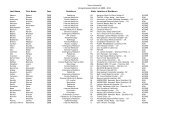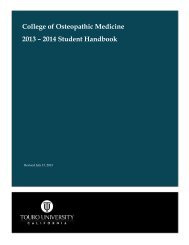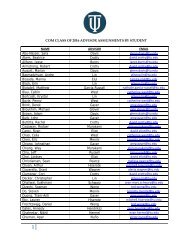2011-2012 - College of Osteopathic Medicine - Touro University ...
2011-2012 - College of Osteopathic Medicine - Touro University ...
2011-2012 - College of Osteopathic Medicine - Touro University ...
You also want an ePaper? Increase the reach of your titles
YUMPU automatically turns print PDFs into web optimized ePapers that Google loves.
The educational program is centered on the basic concepts <strong>of</strong> osteopathic medicine. Theacademic program is intended to meet the following goals:I. To emphasize the role <strong>of</strong> the patient in the maintenance <strong>of</strong> health.II.To recognize and emphasize the inherent capacity within each person toovercome disease and maintain health; to educate physicians to cooperatewith this therapeutic capacity in their methods <strong>of</strong> treatment.III.To <strong>of</strong>fer a curriculum that will interest students in primary care and preparethem to provide quality, comprehensive health care to their patients.IV.To provide sufficient academic training to make students analyze health-caredecisions, promote wellness, and empower patients to assume responsibilityfor their own health.A primary care physician must first <strong>of</strong> all be capable <strong>of</strong> problem solving and thedevelopment <strong>of</strong> expertise in diagnosis. In order to achieve this goal, the curriculumadopted at TUCOM emphasizes the integration <strong>of</strong> basic and clinical science aspects <strong>of</strong>medical practice. With this approach, practice in problem solving becomes a part <strong>of</strong> thedaily classroom and clinic experience. The TUCOM Faculty has adopted the followingcore competencies which will guide curriculum development and assessment.• <strong>Osteopathic</strong> Philosophy and <strong>Osteopathic</strong> Manipulative <strong>Medicine</strong>• Medical Knowledge• Patient Care• Interpersonal and Communication skills• Pr<strong>of</strong>essionalism• Practice-based learning and improvement• Systems-based practiceThe curriculum includes two principal phases:I. Teaching <strong>of</strong> the fundamentals <strong>of</strong> basic sciences, followed by the study <strong>of</strong> theorgan systems <strong>of</strong> the body, incorporating both basic and clinical sciences. This isintegrated with an osteopathic approach to the art and science <strong>of</strong> doctoring includingthe fundamentals <strong>of</strong> history-taking, physical diagnosis, primary care skills, andosteopathic principles, practice, and philosophy.<strong>2011</strong> – <strong>2012</strong> COM Student Handbook





